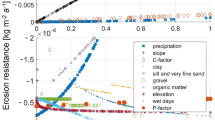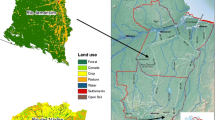Abstract
Following the 1986 Chernobyl accident radiocaesium levels in sheep meat in some upland areas of the United Kingdom were above the national intervention limit. West Cumbria was one of these areas and restrictions are currently still in place. In addition to deposition from the Chernobyl accident, Cumbria has been subject to radiocaesium deposition from atmospheric nuclear weapons tests, the 1957 Windscale accident and routine releases from the Sellafield nuclear reprocessing plant. A Monte-Carlo approach has been used to try to predict areas in west Cumbria where radiocaesium activity concentrations in lamb meat would require the imposition of restrictions at different times after the Chernobyl accident. The approach models the transfer of radiocaesium from soil to vegetation, based upon soil organic matter, and from vegetation to lamb meat. Spatial inputs are soil organic matter and total post-Chernobyl 137Cs and 134Cs deposition; a ratio of Chernobyl 137Cs to 134Cs deposition has been used to differentiate Chernobyl and pre-Chernobyl 137Cs deposition. Comparisons of predicted radiocaesium transfer from soil-vegetation and the spatial variation in lamb 137Cs activity concentrations are good and predicted restricted areas with time after Chernobyl compare well to the restricted areas set by UK government. We predict that restrictions may be required until 2024 and that in some areas the contribution of pre-Chernobyl 137Cs to predicted lamb radiocaesium activity concentrations is significant, such that restrictions may only have been required until 1994 as a consequence of Chernobyl radiocaesium deposition alone. This work represents a novel implementation of a spatial radioecological model using a Monte-Carlo approach.
Similar content being viewed by others
References
McDonough L, Segal MG (1991) Chernobyl fallout in England and Wales: countermeasures research and possible remedial measures by MAFF. In: CEC (eds) Proceedings of seminar on comparative assessment of the environmental impact of radionuclides released during three major nuclear accident: Kyshtym, Windscale, Chernobyl. Volume I. Luxembourg, 1–5 October 1990. Commission of the European Communities, EUR 13574, pp. 1177–1193
Nisbet A, Woodman R (2000) Options for the management of Chernobyl-restricted areas in England and Wales. J Environ Radioact 51:239–254
Wright SM, Howard DC, Barry J, Smith JT (2002) Spatial variation of radiocaesium deposition in Cumbria. Geogr Environ Modelling 6:203–216
Coughtrey PJ (1989) A review of levels and distribution of caesium in upland environments prior to the Chernobyl accident. Report to the Ministry of Agriculture Fisheries and Food. ANS Report No. 2131-1. Associated Nuclear Fuels Ltd., Epsom
Beresford NA, Howard BJ, Barnett CL, Crout NMJ (1992) The uptake of Chernobyl and aged radiocaesium in upland west Cumbria. J Environ Radioact 16:181–195
Sandalls J, Bennett L (1992) Radiocaesium in upland herbage in Cumbria, UK: a three year field study. J Environ Radioact 16:147–165
Horrill AD, Lowe VW, Howson G (1988) Chernobyl fallout in Great Britain. Final report. TFS Project T07006e1. Department of the Environment. Institute of Terrestrial Ecology, Grangeover-Sands
Baker SJ, Cawse PA (1990) A survey of radioactive caesium in soils of Cumbria and north Lancashire. AEA Technology report AEA-EE-0047. AEA Technology, Harwell
Ministry of Agriculture Fisheries and Food and Welsh Office (1987) Radionuclide levels in food, animals and agricultural products—Post Chernobyl monitoring in England and Wales. HMSO, London
Jackson D, Jones SR, Fulker MJ, Coverdale NGM (1987) Environmental monitoring in the vicinity of Sellafield following the deposition of radioactivity from the Chernobyl accident. J Soc Radiol Prot 7:75–87
Fulker MJ (1987) Aspects of environmental monitoring by British Nuclear Fuels plc following the Chernobyl reactor accident. J Environ Radioact 5:235–244
Livens FR, Fowler D, Horrill AD (1992) Wet and dry deposition of 131I, 134Cs and 137Cs at an upland site in northern England. J Environ Radioact 16:243–254
Mück K (1997) Long-term effective decrease of cesium concentration in foodstuffs after nuclear fallout. Health Phys 72:659–673
Smith JT, Fesenko SV, Howard BJ, Horrill AD, Sanzharova NI, Alexakhin RM, Elder DG, Naylor C (1999) Temporal change in fallout 137Cs in terrestrial and aquatic systems: a whole ecosystem approach. Environ Sci Technol 33:49–54
Smith JT, Comans RNJ, Beresford NA, Wright SM, Howard BJ, Camplin WC (2000) Chernobyl’s legacy in food and water. Nature 405:141
Horrill AD, Howard DM (1991) Chernobyl fallout in three areas of upland pasture in West Cumbria. J Radiol Prot 11:249–257
Pomeroy IR, Nicholson KW, Branson JR (1996) Monitoring Chernobyl radiocaesium in Cumbrian grass, 1992–1995. AEA Technology report AEAT/18142002/REMA-197, AEA Technology, Abingdon
Beresford NA, Barnett CL, Crout NMJ, Morris C (1996) Radiocaesium variability within sheep flocks: relationships between the 137Cs activity concentrations of individual ewes within a flock and between ewes and their progeny. Sci Total Environ 177:85–96
Jarvis RA, Bendelow VC, Bradley RI, Carroll DM, Furness RR, Kilgour INL, King SJ (1984) Soils and their use in northern England. Bulletin No. 10. Soil Survey of England and Wales, Harpenden
Beresford NA, Lamb CS, Mayes RW, Howard BJ, Colgrove PM (1989) The effects of treating pastures with bentonite on the transfer of Cs-137 from grazed herbage to sheep. J Environ Radioact 9:251–264
Beresford NA, Barnett CL, Hove K, Mayes RW, Ellis K, Lamb CS (1996) The applicability of AFCF countermeasures in the restricted areas of the UK. Final report. 45 pp. Ministry of Agriculture, Fisheries and Food. Institute of Terrestrial Ecology, Grange-over-Sands
Beresford NA (2002) Radiocaesium variability in upland sheep flocks PhD Thesis, University of Nottingham, Nottingham, UK
Beresford NA, Barnett CL, Hove K, Mayes RW, Dodd BA, Fawcett R (1999) The development and testing of rumen dwelling AFCF delivery devices suitable for upland lambs. Final report RP 0332. Ministry of Agriculture, Fisheries and Food. Institute of Terrestrial Ecology, Grange-over-Sands
Beresford NA, Barnett CL, Mayes RW (2000) Radiocaesium variability within sheep flocks: determination of 137Cs intake in free-ranging sheep. Radiat Environ Biophys 39:207–212
Beresford NA, Mayes RW, Barnett CL, MacEachern PJ, Crout NMJ (1998) Variation in the metabolism of radiocaesium between individual sheep. Radiat Environ Biophys 37:277–281
Beresford NA, Mayes RW, Barnett CL, Lamb CS (2002) Dry matter intake—A generic approach to predict the transfer of radiocaesium to ruminants? Radioprotection-colloques 37 C1:373–378
Bunzl K, Kracke W (1986) Accumulation of fallout 137Cs in some plants and berries of the family Ericaceae. Health Phys 50:540–542
Salt CA, Mayes RW, Colgrove PM, Lamb CS (1994) The effects of season and diet composition on the radiocaesium intake by sheep grazing on heather moorland. J Appl Ecol 31:125–136
Ministry of Agriculture Fisheries and Food and Welsh Office (1988) Radionuclide levels in food, animals and agricultural products—Post Chernobyl monitoring in England and Wales. HMSO, London
Gillett AG, Crout NMJ, Absalom JP, Wright SM, Young SD, Howard BJ, Barnett CL, McGrath SP, Beresford NA, Voigt G (2001) Temporal and spatial prediction of radiocaesium transfer to food products. Radiat Environ Biophys 40:227–235
Beresford NA, Wright SM, Howard BJ, Crout NMJ, Arkhipov A, Voigt G (2002) Aspects of the incorporation of spatial data into radioecological and restoration analysis. In: Radiation legacy of the 20th century: environmental restoration. IAEATECDOC-1280. International Atomic Energy Authority, Vienna, pp 425–436
Wright SM, Crout NMJ, Beresford NA, Sanchez A, Kanyár B (2002) The identification of areas vulnerable to radiocaesium deposition in Hungary. Radioprotection-colloques 37 C1:1175–1180
Food Standards Authority and Scottish Environmental Protection Agency (2002) Radioactivity in Food and the Environment, 2001. RIFE-7. Food Standards Agency and SEPA, London and Stirling
Müller H, Pröhl G (1993) Ecosys-87: a dynamic model for assessing radiological consequences of nuclear accidents. Health Phys 64:232–252
Staaland H, Garmo TH, Hove K, Pedersen Ø (1995) Feed selection and radiocaesium intake by reindeer, sheep and goats grazing alpine summer habitats in southern Norway. J Environ Radioact 29:39–56
Salt CA, Mayes RW, Elston DA (1992) Effects of season, grazing intensity and diet composition on the radiocaesium intake by sheep on re-seeded hill pasture. J Appl Ecol 29:378–387
Cawse PA, Baker SJ (1990) The migration of Cs-137 in peat. AEA Technology report AEA-EE-0014. AEA-Technology, Harwell
Smith JT, Clarke RT, Saxén R (2000) Time dependent behaviour of radiocaesium: a new method to compare the mobility of weapons test and Chernobyl derived fallout. J Environ Radioact 49:65–83
Jackson D, Jones SR (1991) Reappraisal of environmental countermeasures to protect members of the public following the Windscale nuclear reactor accident, 1957. In: CEC (eds) Proceedings of seminar on comparative assessment of the environmental impact of radionuclides released during three major nuclear accident: Kyshtym, Windscale, Chernobyl. Vol. II. Luxembourg, 1–5 October 1990: Commission of the European Communities, EUR 13574, pp. 1015–1039
Smith JT, Hilton J, Lofts S, Tipping EW, Howard BJ, Beresford NA, Howard DC, Sanchez AL, Wright SM, Parekh N, Dodd B, Ineson P, Naylor C (1999) Modelling the chemical availability of radionuclides in upland organic soils. Centre for Ecology and Hydrology Integrating fund final report. Institute of Freshwater Ecology, Wareham
Author information
Authors and Affiliations
Corresponding author
Additional information
Published online: 4 April 2003
Rights and permissions
About this article
Cite this article
Wright, S.M., Smith, J.T., Beresford, N.A. et al. Monte-Carlo prediction of changes in areas of west Cumbria requiring restrictions on sheep following the Chernobyl accident. Radiat Environ Biophys 42, 41–47 (2003). https://doi.org/10.1007/s00411-003-0187-6
Received:
Accepted:
Issue Date:
DOI: https://doi.org/10.1007/s00411-003-0187-6




